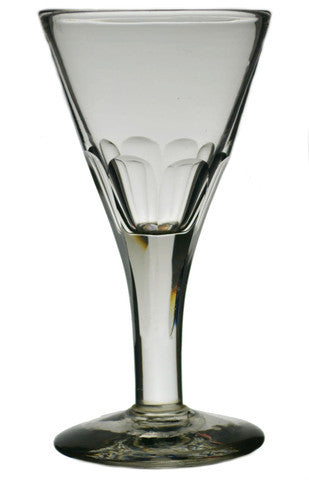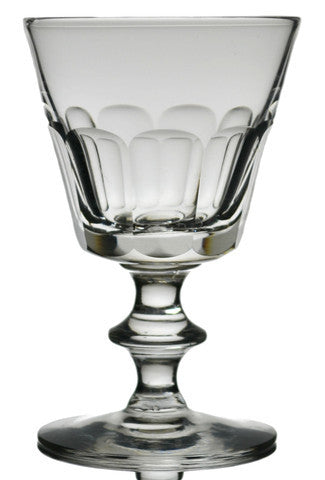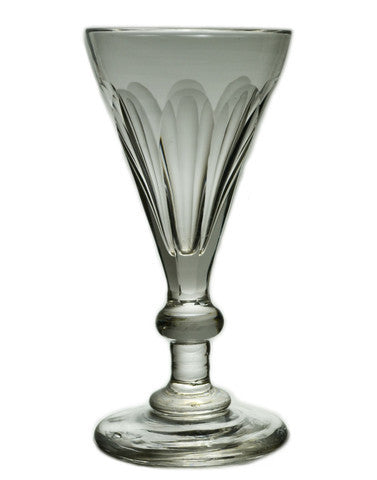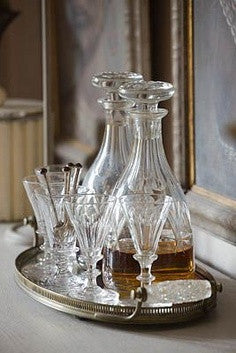Antique Georgian Drinking Glasses 🍷 Wine, Sherry, Port, Punch and Everything in Between

Georgian drinking glasses are but one expression of 18th century English 👑 technical and artistic achievement. Their relative weight and thickness, and the peculiar gleam of the glass itself are innate characteristics of these beautiful vessels. Collectors particularly value them for their great variety of shapes and decorations. Despite the apparent fragility of glassware, Georgian drinking glasses have survived in great enough numbers to be avidly collected today. Although some are extremely rare and therefore expensive, many beautiful and interesting examples can still be found for quite reasonable prices.

💂 Before the end of the 17th century, drinking glasses and glassware were expensive and exclusive luxuries. In refined and wealthy circles, wine, ale, spirits and cordials were drunk from delicate and finely blown glasses that had either been imported from Venice or made elsewhere in Europe by Italian craftsmen. These early drinking glasses were made of soda glass. This was a mixture of soda and silica and the glassware that resulted had a slightly dirty tinge. Italy practically controlled the monopoly for its manufacture.
From the late 17th century, however, England began to rival Italy as an important centre of glass making. In 1674 George Ravenscroft, an English glass-maker, patented a new kind of glass. This was known as lead glass, and contained both lead and silica. By comparison to the normal soda glass, it was exceptionally clear. It was also far less brittle, enabling it to survive engraved decoration without cracking. Glass making industry rapidly developed and by the 1800 there were a few dozens of glasshouses in existence.

Like all glassware made before 1825, early drinking glasses were hand blown. They were made in three separate parts – the bowl, the stem and the foot. First, the bowl was attached to the stem, and then the foot was added. The typical early 18th century drinking glass known as a baluster, had a conical or funnel-shaped bowl, a short, baluster-shaped stem with a pronounced swelling or knop, and a flat, domed or conical foot. As the 18th century progressed, the early balusters evolved into lighter forms, with longer finer stems and smaller knops. Bowls also assumed a wider variety of shapes and engraving, gilding and enamelling were used for decoration.

The old practice of enclosing a bubble of air in the stem evolved into the more complex air-twist stem. This was achieved by trapping a bubble of air in the molten glass for the stem and twisting it, resulting in the delicate swirling patterns. Later similar effects were produced with rods of opaque white and coloured glass. The stems of glasses decorated in this way are called opaque-twist and colour-twist.
Alcoholic drinks of the Georgian period included strong ale, cider, wine, cordials and ratafia (a strongly flavoured liquer), and most of these drinks involved the use of special glass. Strong and potent ale was sipped in modest quantities from glasses with slim and elongated bowls. Often the bowls were engraved with the motifs of hops and barley. Later in the 18th century the hops and barley also decorated such glasses as tumblers, large goblets known as rummers, and other glasses for ale. Glasses with slender, elongated bowls were also suitable for cider and champagne.
Wine glasses also took a variety of shapes. Bowls were mostly trumpet, bell r rounded funnel shaped. A range of motifs besides the appropriate fruiting vine decorated the bowls of wine glasses. Cordial glasses are distinguishable by their small funnel-shaped or ovoid bowls and tall thick stems. Ratafia glasses, also known as flute cordials, had a slender flute-shaped bowl on a tall thick stem. Not only were the bowls of cordial and ratafia glasses beautifully engraved, many also stood on fine air-twist or colour-twist stems.

Toasting glasses resembled cordial glasses, but the characteristically thick walls of the bowl purposely reduced their capacity. This allowed a toastmaster to remain sober while officiating at social occasions. On the contrary, the toasting glasses used by the assembled guests were exceedingly delicate. They generally took the form of undecorated slender flutes. After drinking the toast, the custom demanded to break the glass between the fingers. This practice, which wasted quite a bit of glass, was abandoned by around 1750.
He “firing glasses” had to be sturdy and solid, if they were to withstand the rough treatment to which they were subjected as happy evenings became happier. To signal silence before a toast or a song, drinkers would tap their glasses loudly on the table. The sound that was produced resembled a gunfire, hence creating the term “firing glass”.
The largest and plainest of Georgian drinking glasses were the rummers. The term is derived from Roemer, a German word for a goblet. In their typical form they have a large bucket-shaped bowl and short knopped stem. Many were used in taverns for serving beer, sack, cider as well as mulled wine. Smaller rummers were used for spirits such as gin and rum.

The most common decorative technique used on Georgian glasses was engraving. Enamelling and gilding are rare to find. There were three methods of engraving: scratch engraving, wheel engraving and stipple engraving. Scratch engraving was a straightforward process executed by an iron or diamond point. Emblems and slogans were usually applied by scratch. Wheel engraving was a speciality of Dutch craftsmen. The glass was held to an abrasive wheel. This method was extensively used for such decoration as hops and barley, fruiting vine, floral borders and coat of arms. Stipple engraving was also a Dutch speciality. Built up by clusters of dots, a stipple engraved image appears to have been literally breathed onto the glass surface. The effect is faintly ghostly and the decoration all but invisible until the glass is held to the light.
A genuinely antique glass ❤️ will show slight unevenness and asymmetry that result from hand-blowing. It will also have random scratches and other signs of wear and use to the base, although this is not very difficult to fake. Damaged Georgian drinking glasses have little value on the market. However, chips to the rim and foot can easily be ground off. Grounded glasses will usually have sharper edges. Because drinking glasses are almost never marked, there is no way of attributing a particular maker. Dating is based on the shape of the glass, decoration and quality of the glass.
Remember — your favourite drink tastes better in a perfect early glass! 💯



